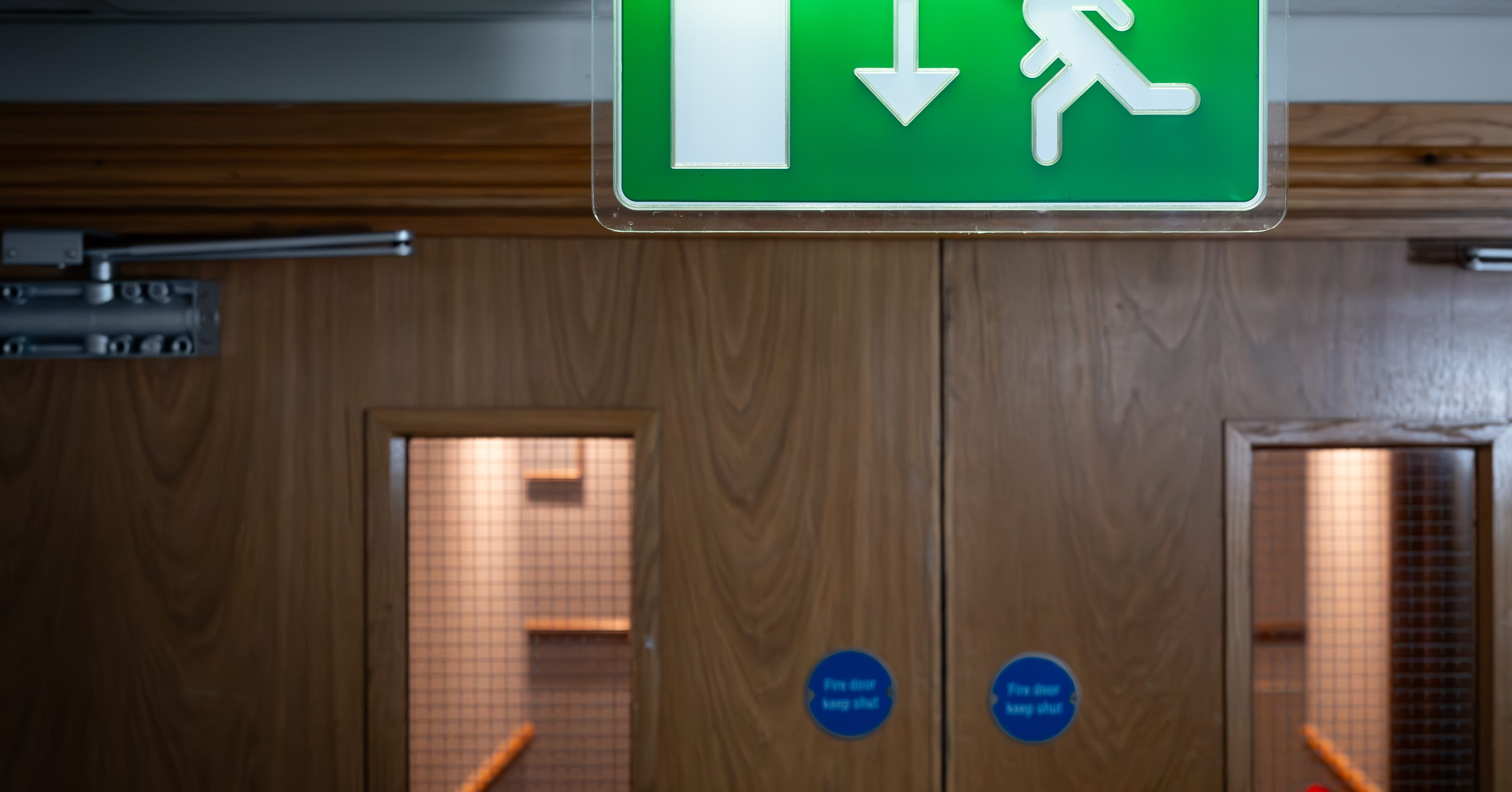
Fire Door Guidance Update: Clarity at Last on What Really Matters
By Anthony Walker FRICS FCIOB MIFireE
Fire Door Guidance Update: Clarity at Last on What Really Matters, an article by Anthony Walker FRICS FCIOB MIFireE
The Ministry of Housing, Communities and Local Government has issued a crucial update to the Fire Safety (England) Regulations 2022 fire door guidance, view here. This provides welcome clarity after some confusion and unnecessary burden.
The Reality Check We All Needed
Since the Fire Safety (England) Regulations 2022 came into force in January 2023, I’ve witnessed some Responsible Persons, and their advisers misinterpret the scope and intent of these regulations. As a result, some leaseholders have received demands to replace perfectly adequate flat entrance doors simply because they weren’t manufactured to today’s standards for new buildings.
In some instances, wholesale door replacement programmes have taken place. These cost individual leaseholders thousands of pounds, all based on a fundamental misreading of legal requirements. Some Fire Safety advisers, perhaps erring on the side of caution, have recommended upgrades that go beyond regulatory requirements.
What’s Actually Changed in the August 2025 Update
The August 2025 update includes revisions to three key guidance sections:
1. Section 2.4 now provides clearer guidance on responsible persons’ duties under Regulation 10. It emphasises that their role is maintaining doors in the condition determined by the fire risk assessment, not upgrading them to current standards.
2. Section 6.7 has been extensively revised to focus on elements for consideration during fire door inspections. It explicitly clarifies that checks should focus on functionality and condition rather than certification to current standards.
3. The summary box at the guidance’s end now provides crystal-clear takeaways. Responsible persons can use these to explain requirements to leaseholders and other stakeholders.
Most significantly, the checklist now clarifies that doors may be acceptable even if intumescent strips and smoke seals are not present, provided they were manufactured to earlier standards and subject to the findings of the Fire Risk Assessment. This single change may prevent countless unnecessary fire door upgrades and replacements nationwide.
The Grenfell Connection: What These Regulations Actually Address
Understanding this is critical: the Fire Safety (England) Regulations 2022 were introduced to implement specific recommendations from the Grenfell Tower Inquiry. The inquiry didn’t recommend wholesale replacement of existing fire doors. Instead, it emphasised the vital importance that flat entrance doors must be effectively self-closing.
The Grenfell inquiry highlighted several specific issues: doors that didn’t close properly due to faulty or missing self-closers, doors that had been wedged open, and doors where fire-resisting integrity had been compromised by poor maintenance or inappropriate modifications. Notably, the inquiry didn’t suggest that older doors built to previous standards were inherently unsafe.
The regulations address practical fire safety concerns, not impose current Building Regulations standards on existing buildings. There’s a fundamental difference between ensuring a door functions properly in a fire and requiring it to meet today’s certification requirements for new construction.
Distinguishing Risk Assessment from Routine Checks
Confusion has existed regarding the relationship between fire risk assessments under the Regulatory Reform (Fire Safety) Order 2005 and the routine checks required by Regulation 10.
The recent regulatory notices serve as a critical reminder of the importance of prioritising tenant safety above all else.
Fire Risk Assessments are comprehensive evaluations carried out by competent persons. They should evaluate whether fire doors provide adequate protection based on expert risk judgement. This is where decisions about door adequacy are made, considering the building’s construction, occupancy, means of escape, and overall fire safety strategy.
Routine Checks under Regulation 10 are simple, visual inspections. Building staff or managing agents can carry these out to ensure doors remain in the condition assessed by the fire risk assessment. These checks aren’t meant to be technical assessments—they’re maintenance monitoring.
These are complementary processes, not competing ones. The routine checks don’t replace the deeper fire risk assessment—they help maintain the standard it establishes.
The FD30/FD30S Misconception
Some had the view that every existing flat entrance door must achieve current FD30S certification. This misconception has driven unnecessary panic and expense across the residential property sector.
The updated guidance explicitly states that the absence of intumescent strips and smoke seals does not imply that a door is unfit for purpose.
Many older doors were built to earlier standards without modern smoke control or intumescing components, but can still provide adequate fire protection. These “notional” fire doors – doors that satisfied the standards applicable when the building was constructed – will usually continue to be acceptable unless there’s a specific need to improve their performance.
The key principle is that fire resistance depends on the door as a system: the door leaf, frame, hinges, locks, and self-closing device working together. Focusing solely on whether modern sealing strips are present misses the broader question of whether the system performs adequately.
Practical Implications for Responsible Persons
For building owners, facilities managers, and managing agents, this update provides much-needed clarity:
- Focus on functionality, not paperwork. The primary concern should be whether doors close properly, self-closers work effectively, and there’s no significant damage that could compromise fire performance.
- Don’t panic about missing certification. Older doors without modern certificates can still be compliant if they’re maintained and fit for purpose. The absence of an FD30S certificate doesn’t create a legal obligation to replace the door.
- Prioritise regular maintenance over wholesale replacement. The regulations emphasise keeping doors in good working order, not upgrading to current standards. A well-maintained 20-year-old door will typically outperform a poorly maintained modern one.
- Document your checks systematically. Keep records of inspections and any remedial work, but remember you’re checking condition and functionality, not attempting to retroactively certificate doors.
- Work with competent fire risk assessors. Ensure your fire risk assessment properly evaluates existing doors rather than simply recommending wholesale replacement.
Relief for Leaseholders
This clarification should significantly ease the financial pressure on leaseholders who’ve been facing demands for costly door replacements. The Fire Safety (England) Regulations 2022 were never intended to create this burden. The updated guidance makes this crystal clear.
Leaseholders facing demands for fire door replacement should ask specific questions:
- Has someone competent assessed the existing doors?
- What specific defects or inadequacies have been identified?
- Have less costly remedial options been considered?
- Is the recommendation based on actual safety concerns or simply certification requirements?
Maintenance and Inspection Framework
The updated guidance provides clearer direction on what routine door checks should involve:
- Monthly visual checks should focus on obvious defects: doors that don’t close properly, damaged door leaves or frames, missing or broken self-closers, and obstructions preventing proper closure.
- Quarterly functional testing should verify that self-closers work effectively, doors close fully from various opening angles, and there are no significant gaps around the door when closed.
- Annual detailed inspection might include checking hinge condition, lock and latch operation, door and frame alignment, and overall condition of fire-resisting elements.
- Documentation should record the date of inspection, who carried it out, what was checked, any defects identified, and remedial action taken.
Getting the Balance Right
This update represents a return to proportionate, risk-based fire safety management. It reinforces that compliance isn’t about ticking boxes or chasing the latest standards—it’s about ensuring fire doors do their job of protecting escape routes and containing fires.
The construction industry has sometimes been guilty of gold-plating requirements, interpreting guidance as mandates, and creating unnecessary work. This clarification should help us refocus on what actually matters: doors that work when they’re needed.
Risk-based decision making requires considering the specific circumstances of each building:
- What’s the overall fire safety strategy?
- How do the doors fit into the broader fire safety systems?
- What’s the condition and performance of existing doors?
- What would be the impact of failure versus the cost of improvement?
Moving Forward: A Sensible Approach
Those employed in assessing fire doors now have clear government guidance that supports a pragmatic approach. When conducting fire door inspections:
- Assessment before assumption: Evaluate what exists before assuming it needs replacement. Many existing doors will be perfectly adequate when properly maintained.
- Function over form: Focus on whether doors work effectively rather than whether they meet current certification requirements.
- Proportionate response: Match interventions to actual risks. Not every door needs upgrading to current standards.
- Clear documentation: Record decisions and their basis, but don’t get lost in unnecessary bureaucracy.
The updated guidance doesn’t lower safety standards – it clarifies what those standards actually require. A well-maintained older door that closes properly and provides adequate fire separation can be perfectly compliant, even without modern certification.
Conclusion
This update represents a helpful clarification in fire safety regulation that addresses misinterpretation of the Fire Safety (England) Regulations 2022 and returns us to the fundamental principle that fire safety should be proportionate, risk-based, and focused on outcomes rather than process.
The key regulatory clarification confirms that fire door compliance should be assessed based on functionality and condition rather than adherence to current certification standards. This approach aligns with the original intent of the legislation, which was designed to implement specific Grenfell Tower Inquiry recommendations rather than mandate wholesale upgrades to existing building stock.
How can Sircle Help?
We are an independent surveying company who conduct fire door inspections using competent surveyors. We have always taken the approach that existing fire doors can be suitable despite their age, and we assess fire doors sensibly, only making recommendations to replace where it is essential and where the door can no longer fulfil its intended objectives.
We can offer certified Fire Door Inspection Scheme inspectors (CertFD) if required and provide clear action plans in relation to the work required to remediate the fire doors, we inspect to ensure they can continue to serve the life safety function they were designed to.

By Anthony Walker FRICS FCIOB MIFireE
Director at Sircle
